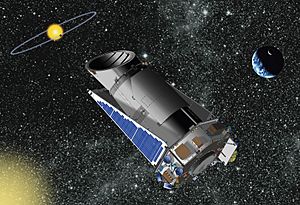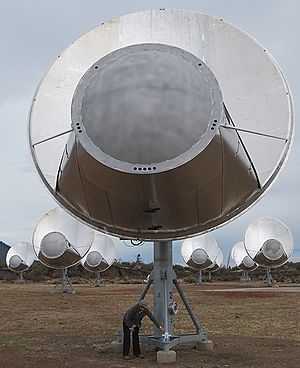Kepler-452b facts for kids
|
Artist's concept of a rocky Earth-sized exoplanet in the habitable zone of its host star, possibly compatible with Kepler-452b’s known data
|
|
| Discovery | |
|---|---|
| Discovered by | Kepler Science Team |
| Discovery site | Kepler |
| Discovery date | 23 July 2015 (announced) |
|
Detection method
|
Transit |
| Orbital characteristics | |
| Star | Kepler-452 |
| Physical characteristics | |
| Temperature | 265 K (−8 °C; 17 °F) |
Kepler-452b is an exoplanet. This means it is a planet that orbits a star outside our Solar System. Some people call it Earth 2.0 or Earth's Cousin because it has some similar features to Earth. NASA sometimes calls it Coruscant.
Kepler-452b orbits a star named Kepler-452. This star is a lot like our Sun. The planet is about 1,402 light-years (430 pc) away from Earth. You can find it in the Cygnus constellation.
The Kepler space telescope found this planet. NASA announced its discovery on July 23, 2015. It was the first rocky super-Earth found in the habitable zone of a star very similar to the Sun. The habitable zone is the area around a star where it's not too hot and not too cold for liquid water to exist. Liquid water is important for life as we know it.
The planet is about 1,400 light-years away from our Solar System. If you traveled at the speed of the New Horizons spacecraft, which is very fast (about 59,000 km/h (37,000 mph)), it would still take about 26 million years to get there!
Contents
Planet Characteristics
Kepler-452b is likely a terrestrial planet, meaning it has a solid, rocky surface like Earth. Scientists think it might be about five times heavier than Earth. Its gravity could be twice as strong as Earth's. However, it's hard to know the exact mass of exoplanets.
If Kepler-452b is a rocky super-Earth, it might have many active volcanoes. This is because of its larger mass and density. The planet's clouds might be thick and misty, covering much of its surface.
Orbit and Size
Kepler-452b takes 385 Earth days to orbit its star. This is very close to Earth's 365-day year. The planet's radius is 50% bigger than Earth's. This means it is about one and a half times the size of Earth. It is located within the comfortable habitable zone of its star.
The planet's temperature is about 265 K (−8 °C; 17 °F). This is a little warmer than Earth. Kepler-452b is not tidally locked. This means one side of the planet does not always face its star, like our Moon faces Earth. It also has an orbit that is almost a perfect circle.
Its Star: Kepler-452
The star Kepler-452 is a G-type star. This means it is similar to our Sun. It is only 3.7% more massive and 11% larger than the Sun. Its surface temperature is almost the same as the Sun's.
Scientists believe Kepler-452 is about 6 billion years old. This makes it about 1.4 billion years older than our Sun, which is 4.6 billion years old. If you stood on Kepler-452b, its star would look almost exactly like the Sun looks from Earth. However, Kepler-452 is about 20% brighter than our Sun.
Potential for Life
We don't know for sure if Kepler-452b is a rocky planet. But because it is not too big, it is likely to be rocky. It is also not clear if Kepler-452b has environments where life could exist. It orbits a star similar to our Sun, which is a good sign.
However, its star is 6 billion years old. This means it is 1.4 billion years older than our Sun. At this older stage in its life, Kepler-452b gets 10% more energy from its star than Earth gets from the Sun. If Kepler-452b is a rocky planet, it might be experiencing a runaway greenhouse effect. This is like what happened on Venus, where the planet became extremely hot.
But because Kepler-452b is 60% bigger than Earth, it might have a mass of about 5 Earths. This larger mass could help it hold onto any oceans it might have for a longer time. This might prevent a runaway greenhouse effect for another 500 million years. This could give any possible life on the planet another 500 to 900 million years to live there.
Searching for Alien Signals
Scientists from the SETI Institute are already looking at Kepler-452b. SETI stands for "Search for Extraterrestrial Intelligence." This is the first near-Earth-sized planet found in the habitable zone of a Sun-like star.
SETI researchers use the Allen Telescope Array. This is a group of 6-meter (20 feet) telescopes in California. They use these telescopes to scan for radio signals from Kepler-452b. As of July 2015, they had scanned over 2 billion different radio frequencies. They haven't found any signals yet. The telescopes will keep scanning over 9 billion channels in total. They hope to find alien radio signals.
Kepler-452b is 1,400 light-years away from Earth. Light travels incredibly fast, about 9.56×1012 kilometres (6.39×104 AU; 1.010 ly; 5.94×1012 mi) in a year. Even at the speed of light, it would take 1,400 years to reach the planet. The fastest spacecraft we have right now is the New Horizons probe. It passed Pluto in July 2015. It travels at about 56,628 km/h (35,187 mph; 0.00037853 AU/h). At this speed, it would take about 26 million years to reach Kepler-452b.
A scientist named Ryan Weed suggests that with new technology, we might be able to reach Kepler-452b in 12 years. This would involve a spacecraft accelerating very quickly. However, from Earth's point of view, about 1,500 years would still pass due to something called time dilation.
Images for kids
See also
 In Spanish: Kepler-452b para niños
In Spanish: Kepler-452b para niños







